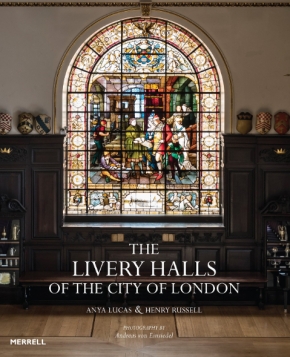The Livery Halls of the City of London

|
| The Livery Halls of the City of London, Anya Lucas and Henry Russell with photography by Andreas von Einsiedel, Merrell Publishers, 2018, 280 pages, 450 illustrations, hardback. |
For many visitors to London, the livery halls may go unnoticed. Tucked down alleys or accessed through gateways, they quietly house the business and history of their company. Yet the livery companies and their halls are integral to the story of the city, woven through its history as tightly as their buildings are through its streets. As Alderman Charles Bowman writes in the foreword, they are ‘unique jewels that greatly enhance the city’s rich architectural history’. Often perceived as aloof and unapproachable institutions, this hugely welcome book opens the doors to all 40.
The history of the livery companies and their buildings mirrors the history of the city itself. Many were formed in the medieval period and took on existing buildings, often courtyard houses, developing and extending them over the Tudor and Stuart period as their trades prospered. The Great Fire of London devastated all of them, but the livery halls were among the first buildings to be reconstructed in the years following the fire, embracing the new baroque style of architecture. Many continued to be developed over the next two-and-a-half centuries, only for the Blitz to devastate the majority again in 1940–41. The Mercers’, Grocers’, Girdlers’ and Painters’ Halls were among many that were completely lost for a second time. Substantial 17th-century fabric survives in only five halls, the Apothecaries Hall of 1672 being the oldest.
The book starts and ends with useful essays by Anya Lucas on the history of the Livery Halls, including numerous plans and illustrations of many of the earlier halls. What architectural losses there have been! Work by Inigo Jones, Christopher Wren, Edward Jarman, Peter Mills and Robert Hooke went up in flames in either 1666 or 1940–1. The Livery Halls’ resilience and capacity to absorb these misfortunes has been extraordinary: Mincing Lane had seen six versions of the Clothworkers’ Hall; Gresham Street five Wax Chandlers’ Halls. Pevsner wrote of them: ‘Their survival against the odds is a remarkable feature of the City’s history.’ This tradition continues: the ever-changing face of the city is represented by new livery companies being formed, the most recent being that for Information Technologists founded in 1992.
The bulk of the book runs through the 40 extant livery halls, not in alphabetical order, but in order of precedence, first established in 1515. The history of each hall is given in brief with a plethora of interesting facts and gorgeous photography of (mainly) the interiors by Andreas von Einsiedel. What is striking is the range of architectural styles, from the baroque through every architectural phase to modern interpretations of Livery Halls at the Leathersellers’ Hall by Eric Parry Architects and the Haberdashers’ Hall by Michael Hopkins. The odd one out is the Master Mariners’ Hall – not a hall at all but a boat – the HQS Wellington.
This book is a great addition to reference works on the architecture of the City of London and the Worshipful Company of Architects must be applauded for masterminding it.
This article originally appeared as ‘Thirty-nine halls and a boat’ in IHBC's Context 158 (Page 61), published in March 2019. It was written by Kate Judge, freelance architectural Historian.
--Institute of Historic Building Conservation
Related articles on Designing Buildings
- After the Fire: London churches in the age of Wren, Hooke, Hawksmoor and Gibbs.
- Coal holes, pavement lights, kerbs and utilities and wood-block paving.
- Conservation.
- Heritage.
- Historic building.
- IHBC articles.
- London.
- Nikolaus Pevsner.
- Sir Christopher Wren.
- Stuart architecture.
- The Institute of Historic Building Conservation.
- The Rebuilding Acts.
- Worshipful Company of Constructors.
IHBC NewsBlog
Old Sarum fire in listed (& disputed) WW1 Hangar - Wiltshire Council has sought legal advice after fire engulfed a listed First World War hangar that was embroiled in a lengthy planning dispute.
UK Antarctic Heritage Trust launches ‘Virtual Visit’ website area
The Trust calls on people to 'Immerse yourself in our heritage – Making Antarctica Accessible'
Southend Council pledge to force Kursaal owners to maintain building
The Council has pledged to use ‘every tool in the toolbox’ if urgent repairs are not carried out.
HE’s Research Magazine publishes a major study of the heritage of England’s suburbs
The article traces the long evolution of an internal programme to research 200 years of suburban growth
IHBC Context 183 Wellbeing and Heritage published
The issue explores issues at the intersection of heritage and wellbeing.
SAVE celebrates 50 years of campaigning 1975-2025
SAVE Britain’s Heritage has announced events across the country to celebrate bringing new life to remarkable buildings.
IHBC Annual School 2025 - Shrewsbury 12-14 June
Themed Heritage in Context – Value: Plan: Change, join in-person or online.
200th Anniversary Celebration of the Modern Railway Planned
The Stockton & Darlington Railway opened on September 27, 1825.
Competence Framework Launched for Sustainability in the Built Environment
The Construction Industry Council (CIC) and the Edge have jointly published the framework.
Historic England Launches Wellbeing Strategy for Heritage
Whether through visiting, volunteering, learning or creative practice, engaging with heritage can strengthen confidence, resilience, hope and social connections.














